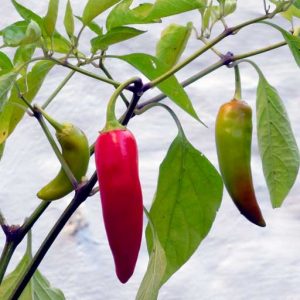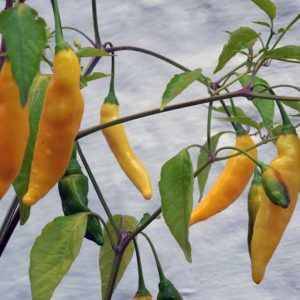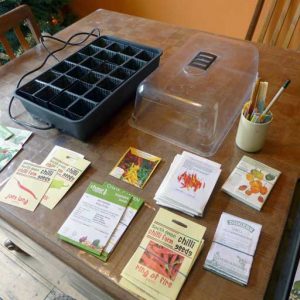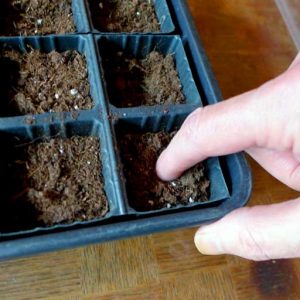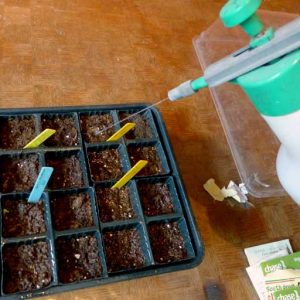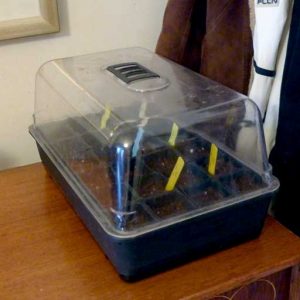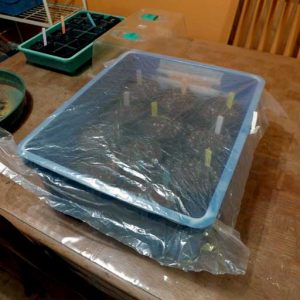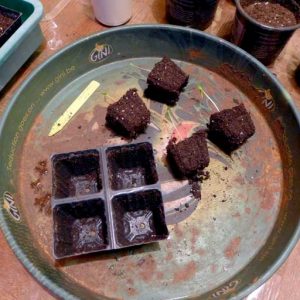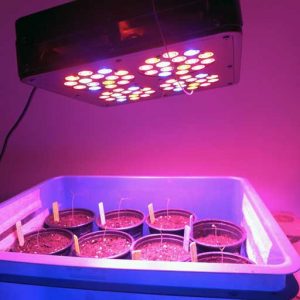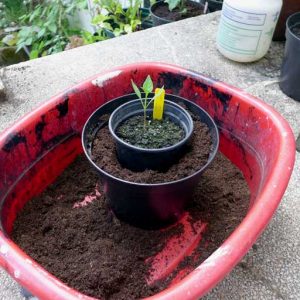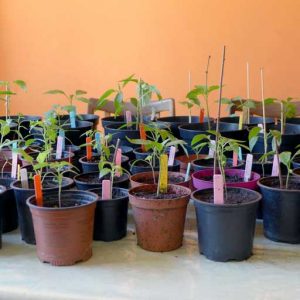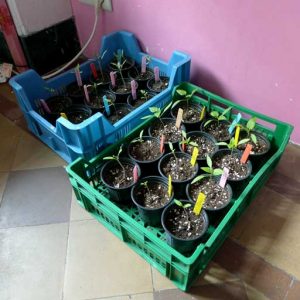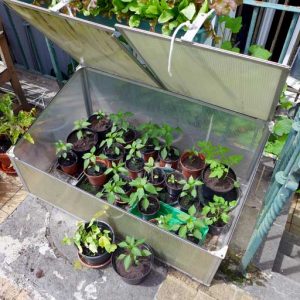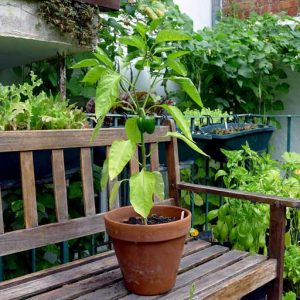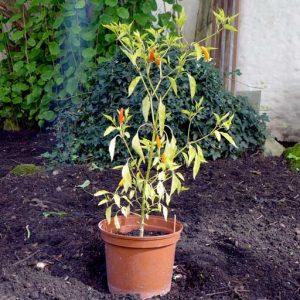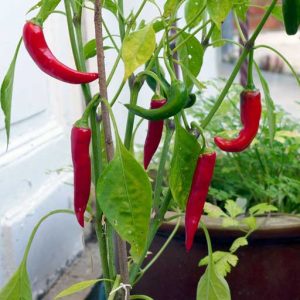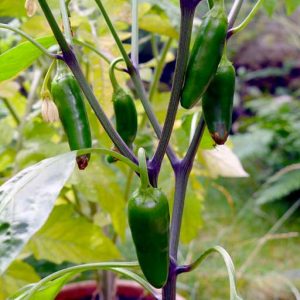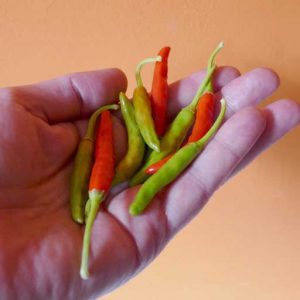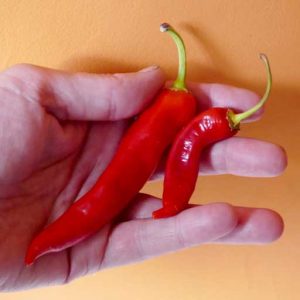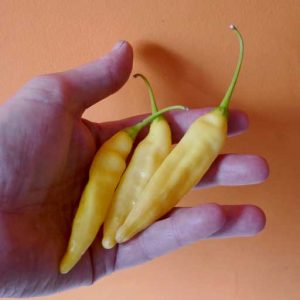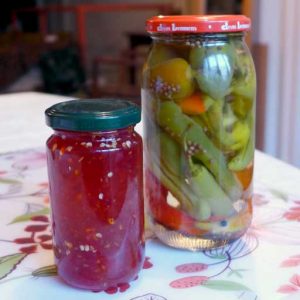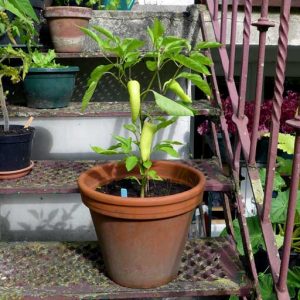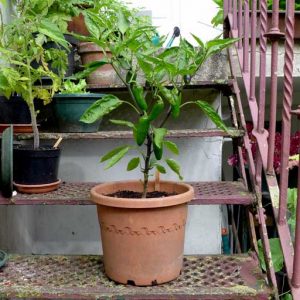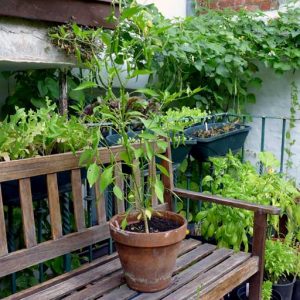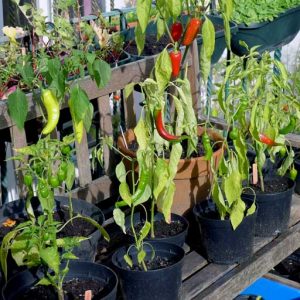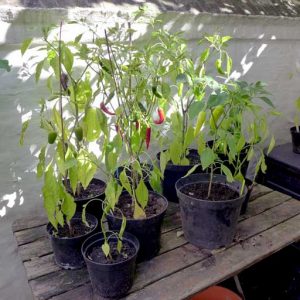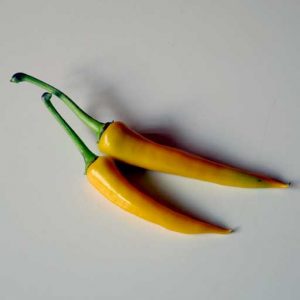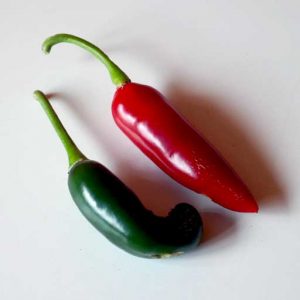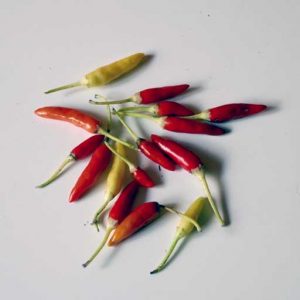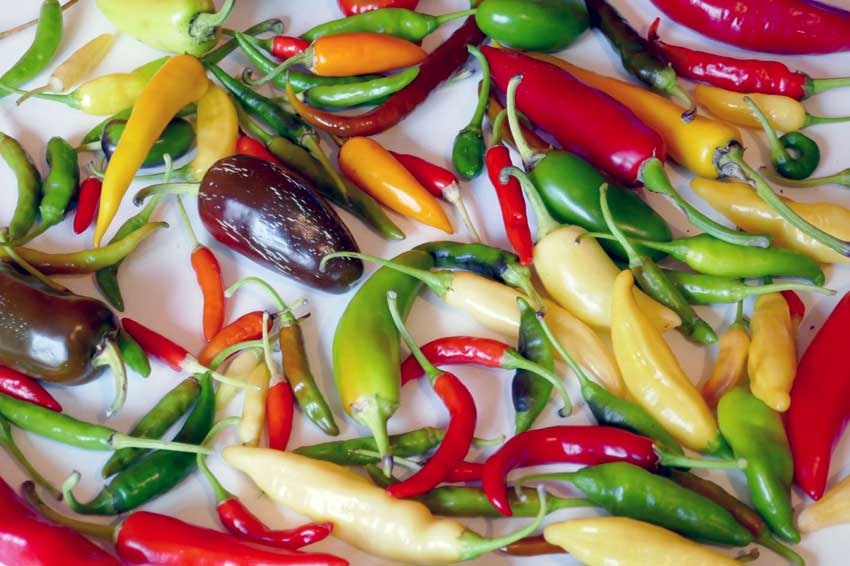Chilli peppers are the quintessential ingredient in a wide range of cuisine from across the world. Originally from South America and the Caribbean region, the chilli pepper has found its way into national dishes from Asia to India and Europe. Universally popular, they are enjoyed for their ability to liven up virtually any dish.
Growing chilli peppers for kitchen use is one of the most satisfying small scale gardening exercises in that a single plant, or several plants, can provide a constant supply of spice for a wide range of meals throughout the year. Whether a single plant on the kitchen windowsill, one or two on a balcony or several in a garden plot, chilli peppers are an excellent component of any vegetable garden.
There are hundreds of types of chilli pepper. Capsicum annuum (sweet peppers and chillies) are the most common and extensively cultivated of the five domesticated capsicums. This species encompasses a wide range of shapes and sizes of peppers, both mild and hot, ranging from bell peppers to chilli peppers. Cayenne, jalapenos, and serranos are Capsicum annuum.
The other domesticated cultivars include Asian hot peppers and tabasco peppers which are Capsicum Frutescens. The hot Habaneros and Scotch Bonnet peppers are Capsicum chinense, while the extra hot Aji peppers, such as Aji Amarillo and Aji Cristal, belong to Capsicum baccatum. The wild chilli peppers chiltepíns and chillipiquíns from Mexico are Capsicum glabriusculum.
As usual with gardening terminology, chilli fruits are considered vegetables when green, a spice when red and dried, but are classified as berries botanically. Chilli peppers for culinary use are usually determined from their particular individual characteristics, such as pungency, colour, shape, flavour, size, and use. Thus particular meals can require particular varieties of pepper.
The infamous heat signature of the chilli pepper comes from the chemical capsaicin, known to stimulate the production of endorphins, which produce a sense of well being thus contributing to ideas that chilli peppers are good for health. This heat is measured using the Scoville Organoleptic Scale, created in 1912 and ranges from the mildest chillies under 5,000 units to the hottest over 30,000 units.
Scoville Heat Units
| 1,600,000 – 2,200,000 | Carolina Reaper |
| 855,000 – 2,199,999 | Komodo Dragon Chilli Pepper, Trinidad Moruga Scorpion, Naga Viper pepper, Infinity Chilli, Naga Morich, Bhut Jolokia (ghost pepper), Trinidad Scorpion Butch T pepper, Bedfordshire Super Naga, Spanish Naga Chilli |
| 350,000 – 580,000 | Red Savina habanero |
| 100,000 – 350,000 | Habanero chilli, Scotch bonnet pepper, Datil pepper, Rocoto, Madame Jeanette, Peruvian White Habanero, Jamaican hot pepper, Fatalii, Wiri Wiri |
| 100,000 – 225,000 | Bird’s eye chilli |
| 50,000 – 100,000 | Byadgi chilli, Malagueta pepper, Chiltepin pepper, Piri piri, Pequin pepper, Siling Labuyo |
| 30,000 – 50,000 | Guntur chilli, Cayenne pepper, Ají pepper, Tabasco pepper, Capsicum chinense, Serenade chilli |
| 10,000 – 23,000 | Serrano pepper, Peter pepper, Chile de árbol, Aleppo pepper, Chungyang Red Pepper |
| 3,500 – 10,000 | Guajillo pepper, Espelette pepper, Fresno pepper, Jalapeño, Wax (e.g. Hungarian wax pepper) |
| 1,000 – 4,000 | Jalapeño pepper, Gochujang, Pasilla pepper, Peppadew, poblano (or ancho), Poblano verde, Rocotillo pepper |
| 100 – 900 | Banana pepper, Cubanelle, paprika, Peperoncini, Pimento |
| 0 | Bell Pepper |
Capsaicin is a volatile oil that can burn skin and cause pain lasting for days. When handling hot peppers latex or plastic gloves are advised. Make sure not to touch any part of the body, particularly the eyes or mouth. If burning occurs, wash hands with dish soap, or hold a towel dipped in milk over the affected area. Do keep chillies away from young children.
Growing chillies
Chilli plants generally grow to about one metre tall though dwarf varieties are available. They can be grown indoors and outdoors. There is a common misunderstanding that chillies require desert like heat conditions and strong sunshine. This is not true and while the plant does require a good constant temperature through its main growing period, once established the plant does very well in a general Belgium summer.
The problem with chillies is getting them started. Chilli seeds take a long time to germinate and do not have a high germination rate compared to other vegetables. Out of 10 seeds planted only 3 may appear. Generally it can take between 3 to 5 weeks to germinate chilli pepper seeds or then again, some seeds will sprout within a few days while others never come up at all.
The good thing about this is that chillies provide the gardener with hours of harmless entertainment indoors during the months of January and February when nothing much else is happening in the garden. Starting the chilli seeds becomes the first gardening task of the year and for some, whole areas of the house become germination laboratories for experimentation. The real art of growing chillies is getting the seeds to germinate, after that, the plants look after themselves.
As with all seed germination there are all sorts of tricks and propagation aids that can be used. Some chilli enthusiasts use high tech heated propagators of various shapes and sizes, and degrees of complexity. This is to be encouraged, but is not essential, for while the seeds and seedlings are very sensitive, the basic process of germination is about alternating the seed’s condition from that of winter dormancy into that of spring time growing.
One such trick for encouraging difficult seeds to sprout is to soak them before planting as this weakens the shell barrier so the seedlings can sprout through easier. This can be achieved through wrapping seeds in paper towel and immersing in a cup of water for 24/48 hours. Using very hot water can accelerate the softening of the seed shell. Similarly, putting the seeds into the freezer for 24/48 hours before wetting can also help kickstart the winter/spring process. The seeds are then placed in individual pots.
Another method is to place the seeds between damp sheets of paper towel in zip lock plastic bag (to maintain moisture level), and store the bag in a warm place such as the top of the refrigerator. Carefully check the seeds every other day until germination occurs. This can be several weeks and the seed wrapping may require to be sprayed with water to prevent drying out. If the seed has sprouted into the paper towel, plant both the seed and the bit of towel into a seedling pot.
It is best to divide up a packet of chilli seeds and try several methods for germination, rather than use them all on one method.
Standard plastic seedling pots with a good quality starting soil (soft) is required for planting chilli seeds. Seeds should be no more than a pencil thickness under the surface and the soil moistened by spray. Ideally the pots should be housed in a basic plastic propagator box as this helps maintain constant conditions. Home made varieties work well using clear plastic sheeting taped over plastic boxes.
A constant temperature is more crucial than light at the germination stage as peppers require an environment where the temperature will remain around 85 degrees. Many hot pepper varieties will not germinate and rot if the temperature is below 85 degrees. After germination the temperature can be turned down to 70 degrees but should remain constant.
Using an airing cupboard or shower room shelf or kitchen shelf for one or two propagation boxes often provides the right consistency of temperature.
See article on Getting Started, Growing From Seed
While the seeds do not need sunlight to germinate, once they sprout they do need light. Artificial light, such as fluorescent light for 10 to 16 hours a day will ensure the seedlings grow slowly and steadily. There is no rush at this stage, indeed it is best to avoid the seedlings shooting up and becoming spindly. If they do, remove seedlings from propagator or cover and let them harden off at room temperature.
Once the seedlings are about 5cm it is worth starting the process of indoor hardening off, which basically means removing them from under plastic but keeping them indoors and away from draughts or cold spots. Chilli plants are very sensitive at this stage and one good dose of cold will kill them, especially if the weather is still cold outside.
There are different opinions about how often chilli seedlings should be potted up to a larger pot before going into their final position (pot or outdoors). As with all seedlings the roots are very sensitive and should not be disturbed. However, once a seedling has reached about 10cm and is looking healthy it is advisable to pot up to a larger pot, either a temporary pot for later transplant or into its final pot for indoor use. This allows the roots to spread and establish for the summer.
The process of hardening off is crucial with chilli peppers. Once the seedlings are established and healthy, and after a period safely contained indoors, the process of hardening off can begin indoors by reducing the heat and even opening a window slightly. This should be done carefully. The plants do need to be hardened off but this should not be rushed. On warmer days the plants can be sat outside for short spells, gradually increasing, but returned indoors at night.
Planting out
The soil in Belgium is generally too cold for chilli plants until the summer heat is established, thus most chilli plants are brought on in pots and even kept there for the whole season. A 30cm depth pot or larger is good for a chilli plant. Chilli plants grow very well in containers and do not need planting in soil beds.
Chilli plants make excellent companion plants with tomatoes, beans and cucumbers. If space is available it is worth planting several of each type of chilli plant thus having plants for regular picking and plants that go to full maturity producing the best flavoured chillies.
Chilli plants can be grouped quite closely together, such as in pots, as the competition for space makes them produce more. It is useful to move potted chilli plants around from the garden space as over the year this indicates which varieties are suited to which spots. It can be surprising how even shaded areas work well in the average summer temperature.
Chilli plants like an element of sand in their soil which is easily achieved by adding a 25% mix with compost in pots. More than most other plants chillies require a well draining soil, almost desert like and will not do well in wet pots or in standing water. Watering little and often works well.
Chilli peppers should be cut from the plant with scissors and not pulled as this damages the plant. Picking can start from the first fruits setting which will encourage further fruit. Most chilli peppers are picked and used in their immature state as the plant grows with only some plants retained for a finished crop of mature fruits. Peppers can be dried or frozen, pickled or kept in oil to provide a light summer heat in cold winter months.
Sweet peppers are from the same family but contain none of the fire. They grow in the same way as hot peppers and plants can produce up to 20 sweet peppers each. They are easy to grow once started. Good varieties include, Corno Rosso, Purple Beauty, Gypsy, Golden Treasure, Gourmet and Topepo Rosso.
Growing chilli peppers and sweet peppers is all about working with the seeds. The plants themselves grow very well in Belgium. The seeds can be sourced by mail from around the world making it possible to grow quite exotic varieties. Their popularity has been growing as tastes for Asian and Indian food has grown. In terms of their productivity a few plants can cover most exotic tastes.
-

Aji Limon
€0.00 View On Original Site -
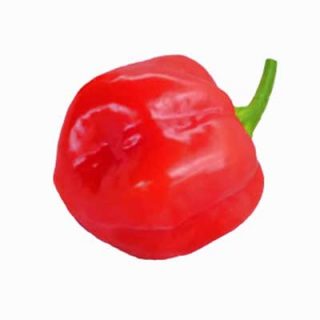
Antillais Caribbean Habanero
€0.00 View On Original Site -
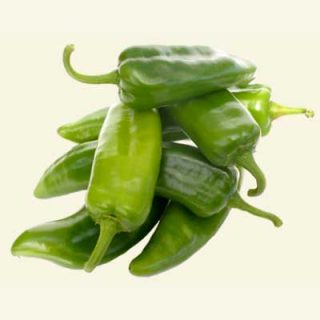
Big Jim Chilli Seeds
€0.00 View On Original Site -

Bulgarian Carrot Chilli Seeds
€0.00 View On Original Site -
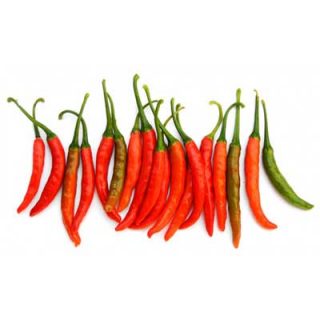
Calcutta Long Pepper
€0.00 View On Original Site -
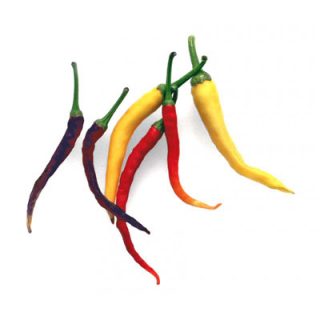
Cayenne Mix
€0.00 View On Original Site -
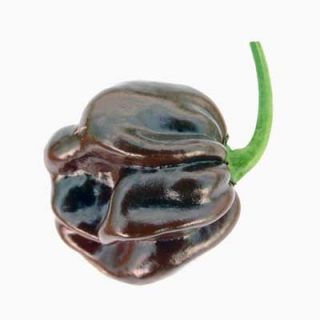
Chocolate Habanero
€0.00 View On Original Site -
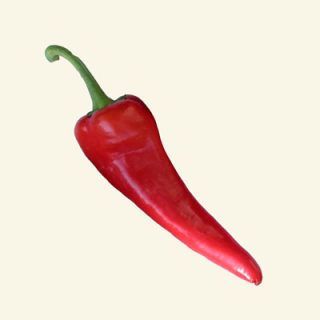
Corno di Toro Seeds (Heatless)
€0.00 View On Original Site


